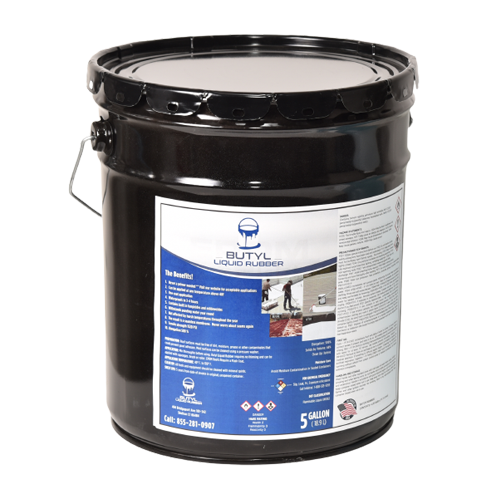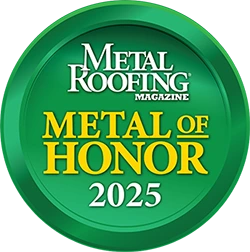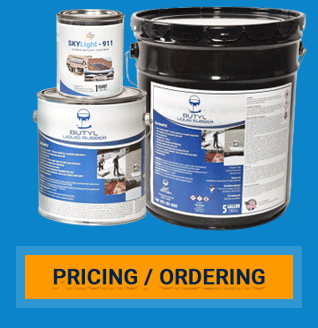This guide covers handling and airless spray application of EPDM Coatings Liquid Butyl Rubber (BLR) single component product. Roof coating contractors and all field application crews using this product should familiarize themselves with procedures for personal safety, workplace precautions and equipment operation. Refer to Product Data Sheet and Safety Data Sheet. For our Liquid Butyl Rubber you do not have to clean out the sprayer hose and it will NOT cure out, which leads to saving time on cleaning. You’ll just have to clean the sprayer tip that is exposed to air and of course the hose when the project is completed.
1. SAFETY EQUIPMENT AND VENTILATION
BLR is air cured solvent-based coating. Spray application creates finely atomized particles and vapors which dictate specific procedures to minimize health and safety risks.
A. Protective Equipment
- Atmospheric levels should be maintained below the exposure guidelines as stated on the SDS. When respiratory protection is required use an approved air-purifying or positive pressure supplied air respirator.
- Industrial protective clothing.
- Industrial protective gloves
B. Outdoor Spraying Precautions
- Rope off the area within the immediate spray area.
- Seal off ventilation intakes within the work area.
- Care should be taken to confine spray mist and avoid damage to nearby surfaces due to overspray.
- Be sure to take proper precautions to not spray over unprotected energized lighting or electrical outlets
2. STORAGE AND HANDLING
A. Storage
- Keep containers closed. Store in a dry, cool place away from heat, sparks, open flame and moisture. Do not store outdoors under direct sunlight.
- For cold weather application, keep material stored above 65°F (18°C).
B. Mixing
- Settling or separation may occur from storage.
- Mix material before using to assure uniform consistency. Use folding blade‐‐‐type mixer for closed head drums.
- Follow equipment manufacturer’s instructions for proper grounding.
C. Thinning
- Thinning of BLR is not required when proper application and ideal climatic conditions exist and adequate equipment is used.
- Xylene or mineral spirits are recommended to clean equipment.
3. SPRAY EQUIPMENT
Airless spray equipment generates very high fluid pressure. Spray equipment must be properly maintained and operated. Any misuse of spray equipment or accessories (such as over‐pressurizing, modified parts, or worn or damaged parts) can result in serious bodily injury, fire, explosion, or property damage. Read and follow the equipment manufacturer’s instructions and recommendations.
A. Airless spray pump must have minimum 3,000 psi output pressure rating and adequate delivery volume to support the spray tip orifice gallons per minute (gpm) rating. High‐pressure airless sprayers with a higher maximum pressure capability will allow spray application in cold weather or using spray hose lengths greater than 250 feet (76.20 meters).
Graco Gas Powered Airless Sprayers
| Part # | Name | Rated PSI | GPM |
|---|---|---|---|
| 249617 | GH 833 | 4000 | 4 |
| 230975 | GH 733 | 3500 | 3 |
Airless sprayers not listed have not been evaluated. The preceding information can be used as a reference and for assembling an alternative equipment system. Refer to equipment manufacturer for more information.
B. Sprayer supply
- Direct immersion is practical for limited quantities supplied in 5 gallon (18.92 L) pails.
- Suction supply directly from pails or drums is sufficient when 1½‐inch (3.81 cm) diameter or larger tube and hose in short lengths are used. Limit hose length to 8 feet (2.44 meters) or less.
- Transfer pump is preferred in some cases to assure positive supply of coating to the airless pump. A 2:1 or 5:1 fluid to air ratio transfer pump of divorced design will supply coating from drums without cavitation and resulting premature pump packing wear. Limit feed pressure to 400 psi.
- Airless spray hose must be grounded. Use only electrically grounded hose designed for paint and solvent. Never exceed maximum working pressure of hose or fittings.
NOTE: To help prevent hose plugging problems, use only moisture resistant hose when spraying BLR.
- Maximum hose length can be as long as 250 feet (76.20 meters). Hose will consist of 150 feet of ¾ inch hose (45.72 cm of 1.90 cm hose) and the balance of ½-inch hose (30.48 cm of 1.27 cm hose).
- A whip hose, 3 feet (0.91 meters), or 6 feet (1.82 meters) in length, and gun swivel are recommended to control spray and reduce operator fatigue. In some conditions the whip hose may cause unsatisfactory spray patterns. Conditions that may cause this are colder temperatures or too long of a spray hose.
- Best performance can be achieved if any fittings that could restrict flow in the suction pipe, pump, or spray hose are replaced.
- Spray gun is a pistol grip flow through gun.
- Spray tip selection is based upon the material delivery volume and spray pattern desired. See table below.
Tip Sizes and Flow Rates
| Orifice Size | ||||||
|---|---|---|---|---|---|---|
| Fan Width | ||||||
| (in.) | (mm) | .031 | .033 | .035 | .039 | |
| 6- 8 | 152-203 | 331 | ||||
| 8-10 | 203-254 | 433 | 435 | 439 | ||
| 10-12 | 254-305 | 531 | 533 | 535 | ||
| 12-14 | 305-356 | 631 | 633 | 635 | ||
| Flow Rate (gpm) | 1.03 | 1.17 | 1.31 | 1.63 | ||
| Flow Rate (l/min) | 3.90 | 4.42 | 4.98 | 6.18 | ||
D. Spray application rate
- . BLR is typically applied at 1.5 gallons per 100 square feet or 24 wet mils, per coat. A base coat and finish coat are typically required for 25-32 dry mil (DFT) specification.
- . If the spray pattern has fingers, tails or pulsates, change spray tips to reduce the size of the spray orifice. This will decrease material delivery volume and increase pressure.
- A filter screen may be used to reduce tip plugging especially when using smaller size tips. Clean filter screen on a regular basis.
4. APPLICATION
A. Climatic conditions
- Rain, fog, dew and frost will react adversely, affecting adhesion and physical properties of coating. Do not apply if any of these conditions exist or will exist within five hours of application. The substrate must be clean, dry and free of any loose impediments or any other foreign matter at the time of application.
- At ambient temperatures below 65° F (18° C) store and maintain material temperature above 65° F in the container prior to application. Spray application is not recommended when material temperatures are below 50° F (7° C). Application is possible when ambient temperature is 35° F and rising by heating the BLR product and/or thinning with APPROVED XYLENE ONLY. Limit the amount of thinner to less than 5% of the BLR volume. NOTE: Any amount greater than 5% will adversely affect the physical properties and performance of the coating. Applicator assumes all responsibility for thinning.
- At temperatures above 85° F (29° C) reduce the application rate on vertical or irregular surfaces to prevent sags or runs. Multiple passes may be necessary.
B. Spraying Technique
- Hold the spray gun perpendicular to the surface at a distance of 18 to 24 inches (45.72 to 60.96 cm). While triggering the spray gun, move it at a rate to produce the desired coating wet mil thickness without thin spots or “holidays.” Spray technique should include a “half lap” technique where each spray pass is overlapped 50% for uniform coverage. Check applied film thickness using a wet mil gauge.
- Use the lowest fluid pressure which will provide a uniform spray pattern without fingering. When greater material coverage is desired, use a larger spray tip orifice size instead of increasing pressure. Excessive pressure could cause excessive overspray.
- Cure time of coating can vary greatly depending on ambient air temperature and humidity
C. Clean-up
- Clean airless spray equipment with Xylene. Recirculate thinner through pump supply, airless spray pump and spray hose to remove residual coating. When using 250 feet (76.20 meters) of hose it can typically take 10 to 15 gallons (37.9 to 56.8 L) of Xylene for the initial flush of the equipment. Flush with clean Xylene another 15 minutes after initial flush.
- Do not leave BLR in airless spray system overnight. It is possible for these coatings to harden if left in the equipment too long. Contractor assumes responsibility for coating left in hoses or equipment beyond these recommendations. Dedicated hoses are also recommended. Do not use same hoses for various coating chemistries.
- For long-term storage, a final flush with Xylene is required. After flushing, spray lines should be capped with mineral spirits still in the lines. Do not blow lines clear with air, as doing so will cause clogging issues.
- Troubleshooting information presented here is specifically for BLR Product data sheets and equipment manufacturer’s operation manual should be referred to for additional information):
| Condition | Areas to Check | Corrective Check |
|---|---|---|
| Poor spray pattern |
|
|
| Pulsating spray pattern |
|
|
| Sags/runs on vertical |
|
|
| Runs off high on spray foam |
|
|
| Foamy or pin-holed coating |
|
|












